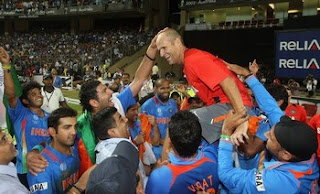The long jump is an explosive event in which speed, rhythm, coordination and consistency are essential.
There are five general objectives to keep in mind while training for and performing the long jump:
- Your speed at take-off
- Your angle of take-off
- The height of the centre of your mass at take-off
- Controlling tour balance and rotations
- An efficient landing
The long jump consists of four phases:
- Approach/run up phase
- The take-off phase
- The flight phase
- The landing phase
The approach/run up phase
The aim of the approach/run up is to achieve a good, controllable velocity. Here, you must find your ideal speed, this will be the maximum velocity you can control without sacrificing distance or technique, too quick and you won't be able to control your take-off and too slow and you won't be able to convert your speed into distance. Once you have your ideal speed you will need to work on your rhythm. A good running rhythm will ensure accuracy on your approach to the board. Next you must establish your run up length. Your run up should be long enough to allow you to obtain your ideal speed but short enough so you don't fatigue before you reach the take-off board. Your run up length is dependent on your age, speed and conditioning level. Keep in mind this is a guideline and not set in stone. Age = Strides
Under 11 = 11
Under 13 = 13
Under 15 = 15
Under 17 = 17
Over 17 = 21
Determining the take-off foot:
Stand with your back to the jumping pit and the heel of your non take-off foot on the take-off board scratch line
Run up the runway the required number of strides, say 19, and have a friend or coach spot your 19th stride and place a marker there.
Place the non-take-off foot on the marker and run back towards the board and take-off. The coach should note where the 17th stride lands in relationship to the take-off board.
If the foot is behind the take-off board, say 15cm, then move the start marker 15cm forward. If the foot is beyond the take-off board then move the marker back.
Repeat the run up and marker adjustment 4 or 5 times to establish a consistent approach run onto the take-off board.
Once achieved measure the distance accurately and record it for future use.
It is important to bear in mind that a head or tail wind will affect the run up. A head wind may mean moving the marker slightly forward.
Take-off phase
The preparation for the take-off begins late in the run up phase. This is done by sinking your hips and then raising your hips into the take-off phase. Your second last stride is usually longer than normal and your last stride, at which you make contact with the board, is always shorter than normal. The hip sink and stride length adjustment are crucial responses by the athlete in preparation for the take-off. Ensure that the hips are slightly forward of the shoulders at take-off. The take-off foot should be slightly ahead of the hips and should strike the board on the mid line. The final two steps in the run up should be flat, slapping contacts.
The vertical impulse is achieved by the upward acceleration of the "free" limbs, the arms and the non-take-off leg, against the braced take off leg. These movements should be characterised by fast explosive actions.
The head should be carried in a normal position, in line with the spine, and the eyes should be focused forward and slightly up and not on the take-off board.
Flight phase
It is important here to control your body. You must control the rotational forces of your body to ensure your flight phase is as long as possible and that you do not over or under rotate as this will result in a loss of distance. Over rotate will cause you to lean forward hitting the ground with your feet to early and under rotating will cause you to lean back making you fall flat on you bum resulting in a loss of distance. You can make use of 3 techniques to optimize your flight phase:
The Stride Jump
In the stride jump style the you maintain the take-off position for as long as possible and only as you come into land does the take-off leg join the free leg for a good landing position.The Hang Style
On take-off you drop the free leg to the vertical, which is then joined by the take-off leg. The arms go overhead to slow down the rotation about the athlete's centre of gravity. The legs are then lifted upwards and forwards whilst lower the trunk. The arms swing past the legs during the landing phase to ensure a good leg shoot.The Hitch-Kick
Following take off your free leg is straightened and swung back and down as the take-off leg folds up beneath the hips and comes forward bent. The take-off leg then continues forward, straightening for landing. Your free leg completes its backward swing behind the hip and then folds up and moves forwards bent, to join the take-off leg ready for landingThe landing phase
Following the flight phase is the landing phase. Here, your heels will need to land just before the projected flight path to ensure that you do not fall back into the sand resulting in a loss of distance. As your feet make contact with the sand, press the heels downwards and contract the hamstrings causing the hips to rise. As your hips rise twist them to one side and allow the forward momentum to carry the body past the landing position.Armant Goldswain






